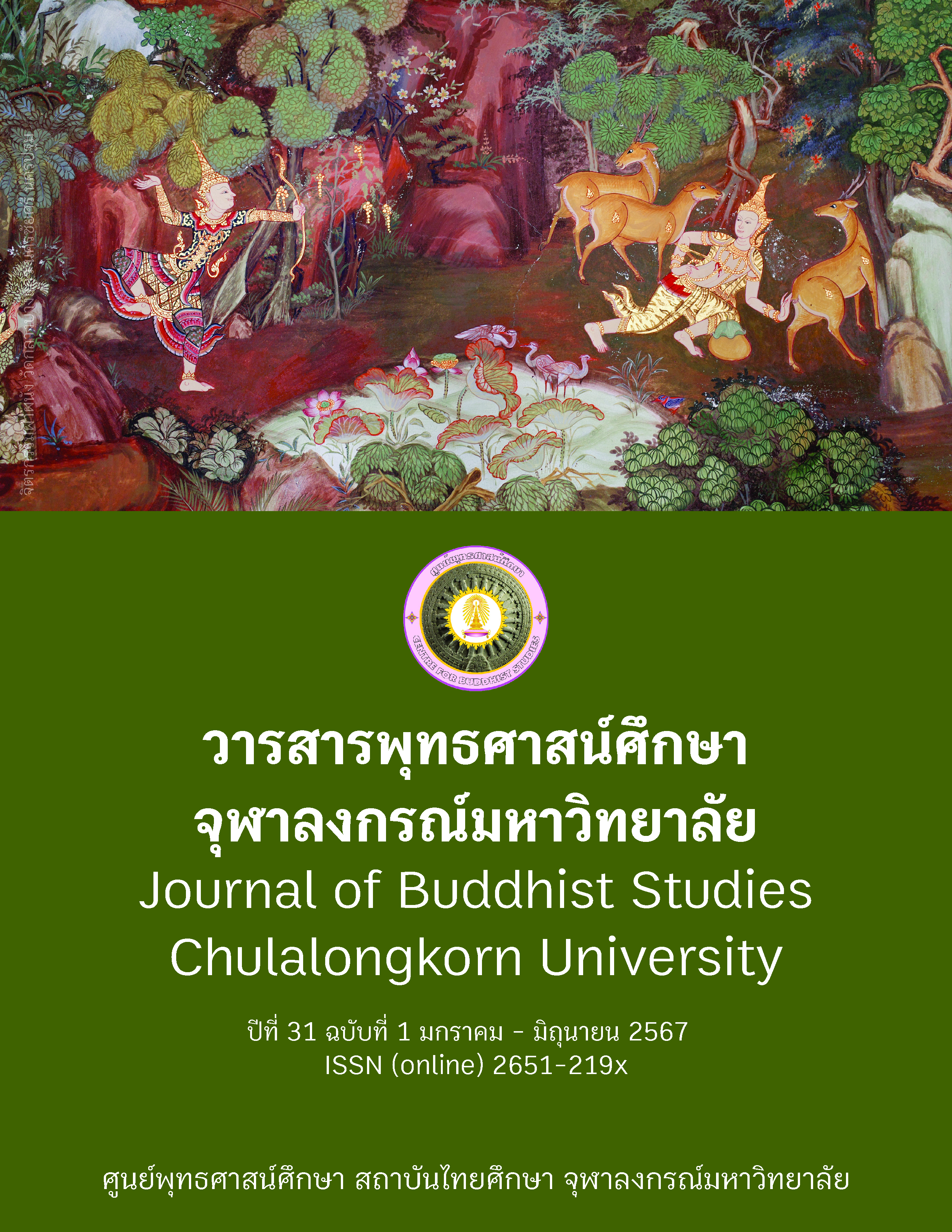The Relationship between Upekkhã and the Noble Eightfold Path
Keywords:
Development, Upekkhā, Buddhist EthicsAbstract
The research aims to clarify the meaning of Upekkhā and the development of Upekkhā in Advanced Buddhist Ethics. The research finds that Upekkhā means seeing approaching the neutrality of mind and seeing stability in the neutrality of the mind resulting from the elimination of defilements of the Noble Eightfold Path. The important process that causes Upekkhā to occur is the creation of the Noble Eightfold Path, which brings about neutrality of the mind. And the most important step in making all 8 Noble Paths happen in unison is to perform effective labeling to create Right Speech consisting of Parikamma-nimitta, Parikamma-bhāvanā, Uggaha-nimitta, and Paṭibhāga-nimitta. Therefore, the development of Upekkhā in Advanced Buddhist Ethics can only be achieved by seriously practicing insight meditation.
Downloads
References
กรุงเทพธุรกิจ. (2557). เหตุที่บ้านเมืองวุ่นวาย. สืบค้นจาก https://www.bangkokbiznews.com/blog/detail/566399
ไชย ณ พล. (2566).จะฝึกอุเบกขาในชีวิตประจำวันอย่างไร. สืบค้นจาก https://uttayarndham.org/dhamma-sharing/5704/%E0%B8%88%E0%B8%B0%E0%B8%9D%E0%B8%B6%E0%B8%81%E0%B8%AD%E0%B8%B8%E0%B9%80%E0%B8%9A%E0%B8%81%E0%B8%82%E0%B8%B2%E0%B9%83%E0%B8%99%E0%B8%8A%E0%B8%B5%E0%B8%A7%E0%B8%B4%E0%B8%95%E0%B8%9B%E0%B8%A3%E0%B8%B0%E0%B8%88%E0%B8%B3%E0%B8%A7%E0%B8%B1%E0%B8%99%E0%B8%AD%E0%B8%A2%E0%B9%88%E0%B8%B2%E0%B8%87%E0%B9%84%E0%B8%A3
ชินสภเถระ. (2558). พระนิพพานนั้นไม่ไกล ถ้าไปให้ถูกทาง. นครนายก: โรงพิมพ์อักษรสัมพันธ์ (1987).
ชินสภเถระ. (2559). พระธรรมจักรเทศนาฎีกา. นครนายก: โรงพิมพ์อักษรสัมพันธ์ (1987).
ชินสภเถระ. (2566). อัปปมัญญาพรหมวิหาร. สืบค้นจาก http://www.buvec.org/home/pdfs/%E0%B8%AD%E0%B8%B1%E0%B8%9B%E0%B8%9B%E0%B8%A1%E0%B8%B1%E0%B8%8D%E0%B8%8D%E0%B8%B2%E0%B8%9E%E0%B8%A3%E0%B8%AB%E0%B8%A1%E0%B8%A7%E0%B8%B4%E0%B8%AB%E0%B8%B2%E0%B8%A3-1.pdf
ณัฐหทัย นิรัติศัย. (2562). พุทธธรรมกับการบำบัดโรคซึมเศร้า. วารสารสถาบันวิจัยญาณสังวร, 10(2), 303-317.
มหามกุฏราชวิทยาลัย. (2556). พระไตรปิฎกและอรรถกถาแปล ชุด 91 เล่ม ฉบับมหามกุฏราชวิทยาลัย (เล่มสีน้ำเงิน). สืบค้นจาก http://www.tripitaka91.com/.
แม้นเหมือน สิทธิศักดิ์. (2561). การประยุกต์หลักอริยสัจ 4 สำหรับการพัฒนาตนและพัฒนางาน. วารสารวิชาการ สถาบันพัฒนาพระวิทยากร, 1(1), 54-66.
ทองย้อย แสงสินชัย. (2561). หัดแผ่อุเบกขากันให้มากๆ. สืบค้นจาก http://dhamma.serichon.us/2018/02/02/%E0%B8%AB%E0%B8%B1%E0%B8%94%E0%B9%81%E0%B8%9C%E0%B9%88%E0%B8%AD%E0%B8%B8%E0%B9%80%E0%B8%9A%E0%B8%81%E0%B8%82%E0%B8%B2%E0%B8%81%E0%B8%B1%E0%B8%99%E0%B9%83%E0%B8%AB%E0%B9%89%E0%B8%A1%E0%B8%B2%E0%B8%81/
ทองย้อย แสงสินชัย. (2564). Admin (เรียบเรียง). มัชฌิมา คือ ตรงกลาง | แต่ “มัชฌิมาปฏิปทา” ไม่ได้หมายถึง ทำอะไรแต่พอดีๆ. สืบค้นจาก http://www.madchima.org/forum/index.php?topic=29905.0;wap2
พระเทพรัตนสุธี (สมศักดิ์ โชตินฺธโร). (2557). การปล่อยวางบนเส้นทางแห่งพระพุทธศาสนา. JOURNAL OF NAKHONRATCHASIMA COLLEGE, 8(1), 65-73.
พระมหานันทกรณ์ ปิยภาณี. (2560), อัตวินิบาตกรรม: แนวทางการแก้ปัญหาการฆ่าตัวตายของคนในสังคมไทยตามหลักพุทธจริยธรรม. (รายงานการวิจัย, วิทยาลัยพุทธศาสตร์นานาชาติ มหาวิทยาลัยมหาจุฬาลงกรณราชวิทยาลัย).
พระพรหมคุณาภรณ์ (ป. อ. ปยุตฺโต). (2553). พจนานุกรมพุทธศาสตร์ ฉบับประมวลธรรม. พิมพ์ครั้งที่ 18. นนทบุรี : โรงพิมพ์เพิ่มทรัพย์การพิมพ์.
พระพุทธทาส อินทปัญโญ. (2556). อุเบกขา. สืบค้นจากhttps://www.youtube.com/watch?v=eaOUYx_wrhQ
พระโสภณมหาเถระ (มหาสีสยาดอ) (รจนา) และ จำรูญ ธรรมดา (แปล). (2564). วิปัสสนาชุนี หลักการปฏิบัติวิปัสสนา (ฉบับสมบูรณ์). พิมพ์ครั้งที่ 3. กรุงเทพมหานคร : ประยูรสาส์นไทย การพิมพ์.
พระอนันตชัย อภินนฺโท (ขันโพธิ์น้อย). (2560). ความทุกข์ในอริยสัจ 4. วารสารพุทธจิตวิทยา, 2(2), 45-58.
พระอนุรุทธาจารย์. (2556). คู่มือพระอภิธัมมัตถสังคหะ. สืบค้นจาก https://www.thepathofpurity.com/%E0%B8%9E%E0%B8%A3%E0%B8%B0%E0%B8%AD%E0%B8%A0-%E0%B8%98%E0%B8%A3%E0%B8%A3%E0%B8%A1/
พระอาจารย์สุชาติ อภิชาโต. (2559). อุเบกขากับการปล่อยวาง. สืบค้นจาก https://www.facebook.com/Abhijato/photos/a.506601929377763/1148212555216694/?type=3&locale=th_TH
สมเด็จพระญาณสังวร สมเด็จพระสังฆราช สกลมหาสังฆปรินายก. (2549). ทศบารมี ทศพิธราชธรรม. ขอนแก่น : หจก. ขอนแก่นการพิมพ์.
สมเด็จพระพุทธโฆษาจารย์ (ป. อ. ปยุตฺโต). (2559). พจนานุกรมพุทธศาสตร์ ฉบับประมวลศัพท์. พิมพ์ครั้งที่ 27. กรุงเทพมหานคร : โรงพิมพ์พระพุทธศาสนาของธรรมสภา.
สมเด็จพระพุทธโฆษาจารย์ (ป. อ. ปยุตฺโต). (2563). ท. ส. ปัญญาวุฑโฒ (โพสต์). ปฏิบัติธรรม ให้ถูกทาง โดย สมเด็จพระพุทธโฆษาจารย์ ( ป. อ. ปยุตฺโต ) ธรรมบรรยาย 9 ก.พ. 2532. สืบค้นจาก https://www.youtube.com/watch?v=NjubVErQO80
สำนักงานราชบัณฑิตยสภา. (2556). พจนานุกรม ฉบับราชบัณฑิตยสถาน พ.ศ. 2554. สืบค้นจาก https://dictionary.orst.go.th/.
หลวงปู่เทสก์ เทสรังสี. (2564). อุเบกขาต้องประกอบด้วยปัญญา. สืบค้นจาก http://www.dhammathai.org/monktalk/dbview.php?No=2388.
Khampan.a (2559). อุเบกขาเจตสิกและอุเบกขาเวทนา เหมือนหรือต่างกัน อย่างไรคะ. สืบค้นจาก https://www.dhammahome.com/webboard/topic/27708
PRASARN MARUKPITAK. (2562). ลงมือทำแทนการวางเฉยหรือก่นด่า. สืบค้นจาก https://prasarnm.com/2019/04/19/take-action/
Additional Files
Published
How to Cite
Issue
Section
License
Copyright (c) 2024 Chulalongkorn University Centre for Buddhist Studies

This work is licensed under a Creative Commons Attribution-NonCommercial-NoDerivatives 4.0 International License.
บทความที่ได้รับการตีพิมพ์เป็นลิขสิทธิ์ของศูนย์พุทธศาสน์ จุฬาลงกรณ์มหาวิทยาลัย
ข้อความที่ปรากฏในบทความแต่ละเรื่องในวารสารวิชาการเล่มนี้เป็นความคิดเห็นส่วนตัวของผู้เขียนแต่ละท่านไม่เกี่ยวข้องกับศูนย์พุทธศาสน์ จุฬาลงกรณ์มหาวิทยาลัย และคณาจารย์ท่านอื่นๆในมหาวิทยาลัยฯ แต่อย่างใด ความรับผิดชอบองค์ประกอบทั้งหมดของบทความแต่ละเรื่องเป็นของผู้เขียนแต่ละท่าน หากมีความผิดพลาดใดๆ ผู้เขียนแต่ละท่านจะรับผิดชอบบทความของตนเองแต่ผู้เดียว






